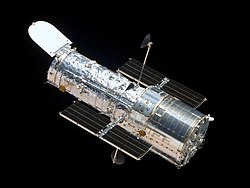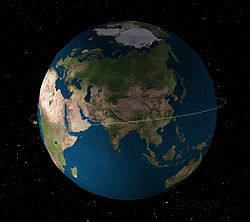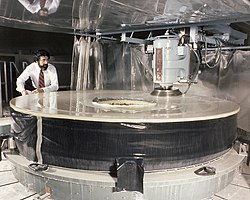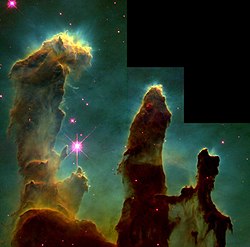Improvement in Hubble images after SMM1
Image on right: The core of the grand design spiral glazy M100, as imaged by WFPC-2 in its high-resolution channel. WRPC-2's modified optics corrected Hubble's previously blurry vision, allowing the telescope for the first time to cleanly resolve faint structures as small as 30 light-years across in a galaxy tens of millions of light-years away. The image was taken on December 31, 1993.
Image on left: For comparison, a picture taken with a WFPC-1 camera in wide-field mode on November 27, 1993, just a few days prior to the STS-61 servicing mission. The effects of optical aberration in HST's 2.4-meter primary mirror blur starlight, smear out fine detail, and limit the telescope's ability to see faint structure.
Both Hubble images were "raw," they were not processed using computer image reconstruction techniques that improved aberrated images made before the servicing mission. The Wide Field and Planetary Camera-2 was developed by the Jet Propulsion Laboratory and managed by the Goddard Space Flight Center for NASA's Office of Space Science.Relevantní obrázky
Relevantní články
Hubbleův vesmírný dalekohledHubbleův vesmírný dalekohled je dalekohled, který na oběžnou dráhu Země do výše 600 kilometrů vynesl v roce 1990 při letu STS-31 americký raketoplán Discovery. Současně obíhá Zemi ve výšce asi 569 km. Dalekohled předává na Zemi obrazy vesmíru neovlivněné zemskou atmosférou. Jeho umístění mimo zemskou atmosféru umožňuje pořizovat velmi ostré snímky vesmírných těles. Od svého vypuštění se stal jedním z nejdůležitějších dalekohledů v historii astronomie a významně se zasloužil o prohloubení poznatků o vesmíru. Přispěl k mnohým klíčovým objevům, které pomohly astronomům lépe porozumět základním problémům astrofyziky. Velmi cenné jsou například snímky tzv. Hubbleových hlubokých polí s nejvzdálenějšími objekty, které zatím lidstvo bylo schopno ve vesmíru pozorovat. .. pokračovat ve čtení
STS-61STS-61 byla mise amerického raketoplánu Endeavour, která probíhala od 2. do 13. prosince 1993. Cílem mise bylo opravit Hubbleův vesmírný dalekohled. Jednalo se zatím o nejsložitější opravu ve vesmíru, na kterou čekali astronomové z celého světa. .. pokračovat ve čtení























